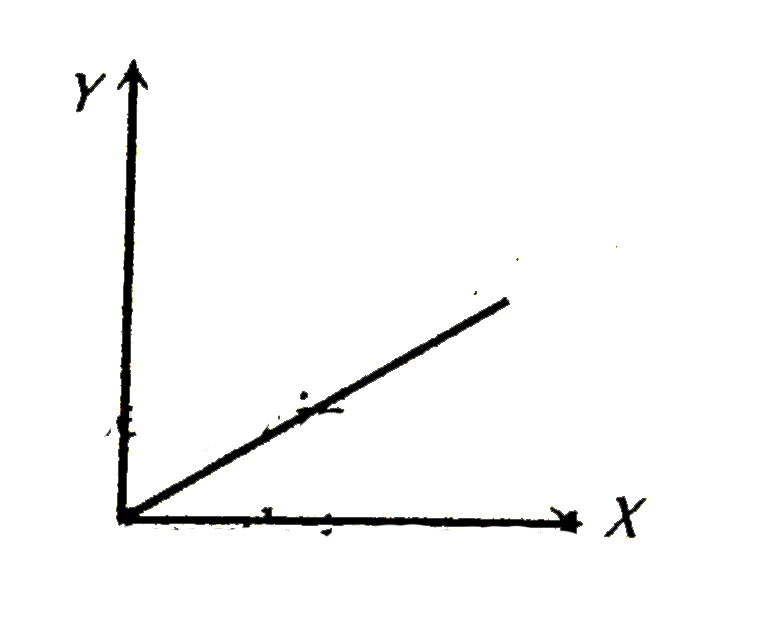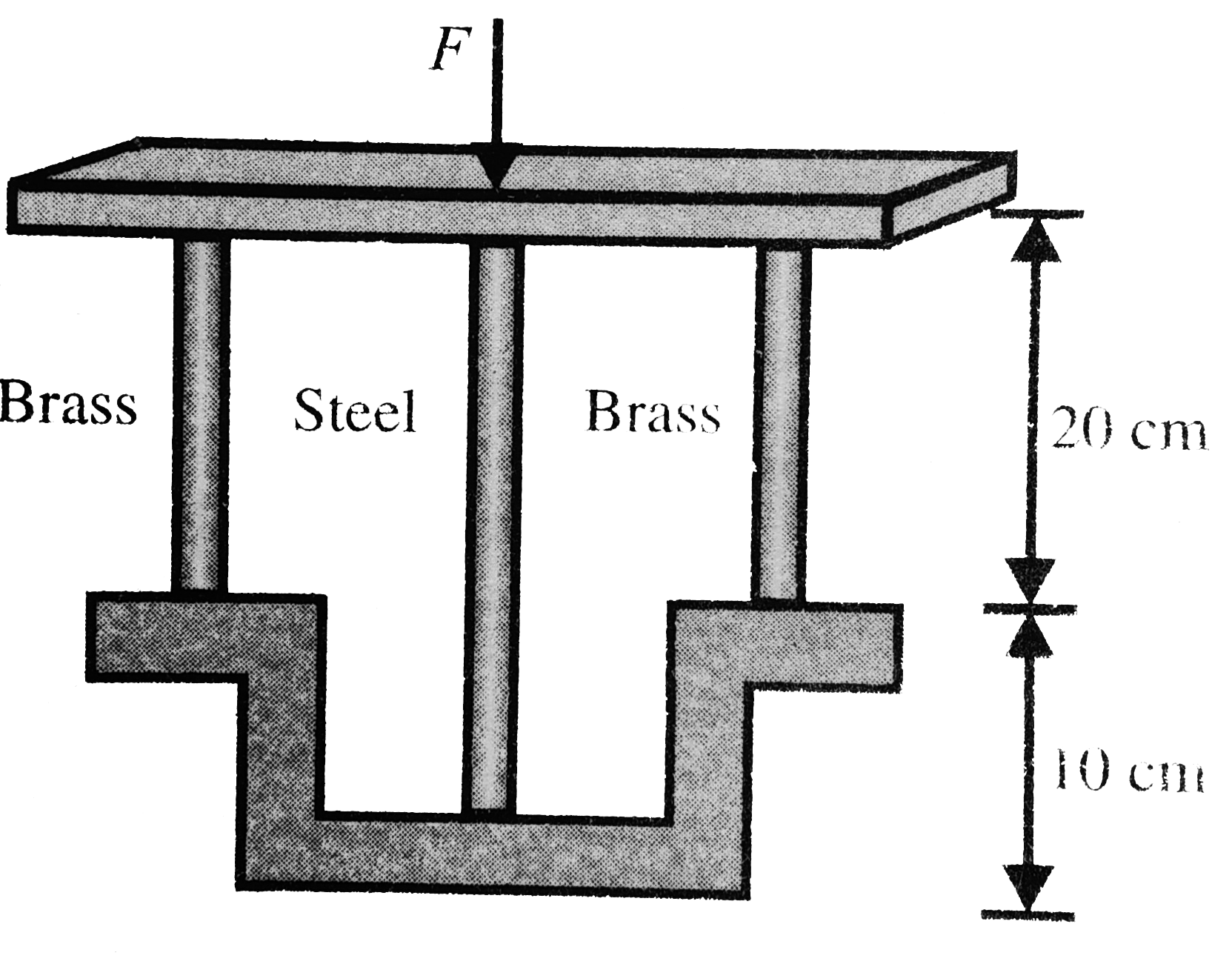A steel rod of cross sectional area 4cm2 and length 2m shrinks by 0.1cm as the temperature decreases in night. If the rod is clamped at both ends during the day hours, find the tension developed in it during night hours. Young modulus of steel =1.9×1011Nm−2Solution in Tamil
The correct Answer is:A, C, D
A=4cm2=4x10−4,L=2m
=△L=0.1cm=10−3,Y=1.9×1011
Y=FA×L△L
→F=YA△LL
1.9×1011×4×10−4×10−32
=3.8×104N
The tension developed is 3.8×104N
Topper's Solved these Questions
- BOOK - HC VERMACHAPTER - SOME MECHANICAL PROPERTIES OF MATTEREXERCISE - Objective-27videos
SOME MECHANICAL PROPERTIES OF MATTER
- BOOK - HC VERMACHAPTER - SIMPLE HARMONIC MOTIONEXERCISE - Exercises58videos
SIMPLE HARMONIC MOTION
- BOOK - HC VERMACHAPTER - SOUND WAVESEXERCISE - All Questions139videos
SOUND WAVES
Similar Questions
A student plots a graph from his reading on the determination of Young's modulus of a metal wire but forgets to label. The quantities on X and Y may be respectively.
 02:37View Solution
02:37View SolutionA particle executes simple harmonic motion with an amplitude of 10 cm and time period 6s. At t=0 it is at position x=5 cm going towards positive x-direction. Write the equation for the displacement x at time t. Find the magnitude of the acceleration of the particle at t=4s.
07:03View SolutionA wave of wavelength 0.60 cm is produced in air and it travels at a speed of 300 ms^-1. Will it be audible?
02:04View SolutionA steel rod is rigidly clamped at its two ends. The rod is under zero tension at 200C. If the temperature rises to 1000C, what force will the rod exert on one of the clapms? Area of cross section of the rod=2.00mm2 . Coefficient of linerar expansion of steel =12.0×10−6^0C−1 and Young's modulus of steel 2.00×1011Nm−2.
02:57View SolutionA steel rod of length l1=30cm and two identical brass rod of length l2=20cm each support a light horizontal platform as shown in Fig. Cross-sectional area of each of the three rods is A=1cm2. A vertically downward force F=5000N is applied on the platform. Young's modulus of elasticity for steel Ys=2×1011Nm−2 and brass Yb=1×1011Nm−2. Find stress (in MPa) developed in a. Steel rod b. Brass rod
 02:15View Solution
02:15View SolutionThe area of a cross section of steel wire is 0.1cm^2 and Young's modulus of steel is 2xx10^(11)Nm^-2 . The force required to strech by 0.1% of its length is
01:28View SolutionThree rods of copper, brass and steel are joined together to form T shape as shown in figure. The cross sectional area of each rod is 4cm^(2) the end of copper rod is maintained at 10^(@)C and the ends of brass and steel rods at 0^(@)C assume there is no loss of heat to surrounding. What is temperature of junction point A in .^(@)C
02:39View SolutionA steel wire of length 20 cm and uniform cross-section 1mm^(2) is tied rigidly at both the ends. If the temperature of the wire is altered from 40^(@)C to 20^(@)C , the change in tension. [Given coefficient of linear expansion of steel is 1.1xx10^(5) .^(@)C^(-1) and Young's modulus for steel is 2.0xx10^(11) Nm^(-2) ]
05:18View SolutionA unifrom steel rod of length 1m and area of cross-section 20cm2 is hanging from a fixed support. Find the increases in the length of the rod.
View SolutionA brass of length 2 m and cross-sectional area 2.0 cm^(2) is attached end to end to a steel rod of length and cross-sectional area 1.0 cm^(2) . The compound rod is subjected to equal and oppsite pulls of magnitude 5 xx 10^(4) N at its ends. If the elongations of the two rods are equal, the length of the steel rod (L) is { Y_(Brass) = 1.0 xx 10^(11) N//m^(2) and Y_(steel) = 2.0 xx 10^(11) N//m^(2)
03:52View SolutionA brass rod of length 2 m and corss-sectinal area 2.0 cm^(2) is attached to end to a steel rod of length L and corss-sectinal area 1.0 cm^(2) . The compound rod is subjected to equal and opposite pulls of magnitude 5 xx 10^(4) N at its ends. If the elongations of the two rods are equal, then the length of the steel rod L is (Y_("brass") = 1.0 xx 10^(11) Nm^(-2) and y_("steel") = 2.0 xx 10^(11) Nm^(-2))
View SolutionA copper rod with length 1.4 m and area of cross-section of 2 cm^2 is fastened to a steel rod with length L and cross-sectional area 1 cm^2 . The compound rod is subjected to equal and opposite pulls to magnitude 6.00xx10^4 N at its ends . (a) Find the length L of the steel rod if the elongation of the two rods are equal . (b) What is stress in each rod ? (c ) What is the strain in each rod ? [Y_"steel"=2xx10^11 Pa , Y_(Cu)=1.1xx10^11 Pa]
09:46View SolutionThere is a change in length when a 33000 N tensile force is applied on a steel rod of area of cross - section 10^(-3) . The change of temperature required to produce the same elongation, if the steel rod is heated, is (modulus of elasticity of steel =3xx10^(11)N//m^(2) , coefficient of linear expansion of steel =1.1xx10^(-5)//^(@)C ........................
03:41View SolutionOn decreasing temperature, the length of steel rod will
03:52View SolutionA steel uniform rod of length 2L cross sectional area A and mass Mis set rotating in a horizontal plane about an axis passing through the centre. If Y is the Young's modulus for steel, find the extension in the length of the rod.
02:45View SolutionA steel rod is rigidly clamped at its two ends. The rod is under zero tension at 20∘C. If the temperature rises to 100∘C, what force will the rod exert on one of the clapms? Area of cross section of the rod =2.00mm2 . Coefficient of linear expansion of steel =12.0×10−6C−1 and Young's modulus of steel 2.00×1011Nm−2.
02:09View Solution

